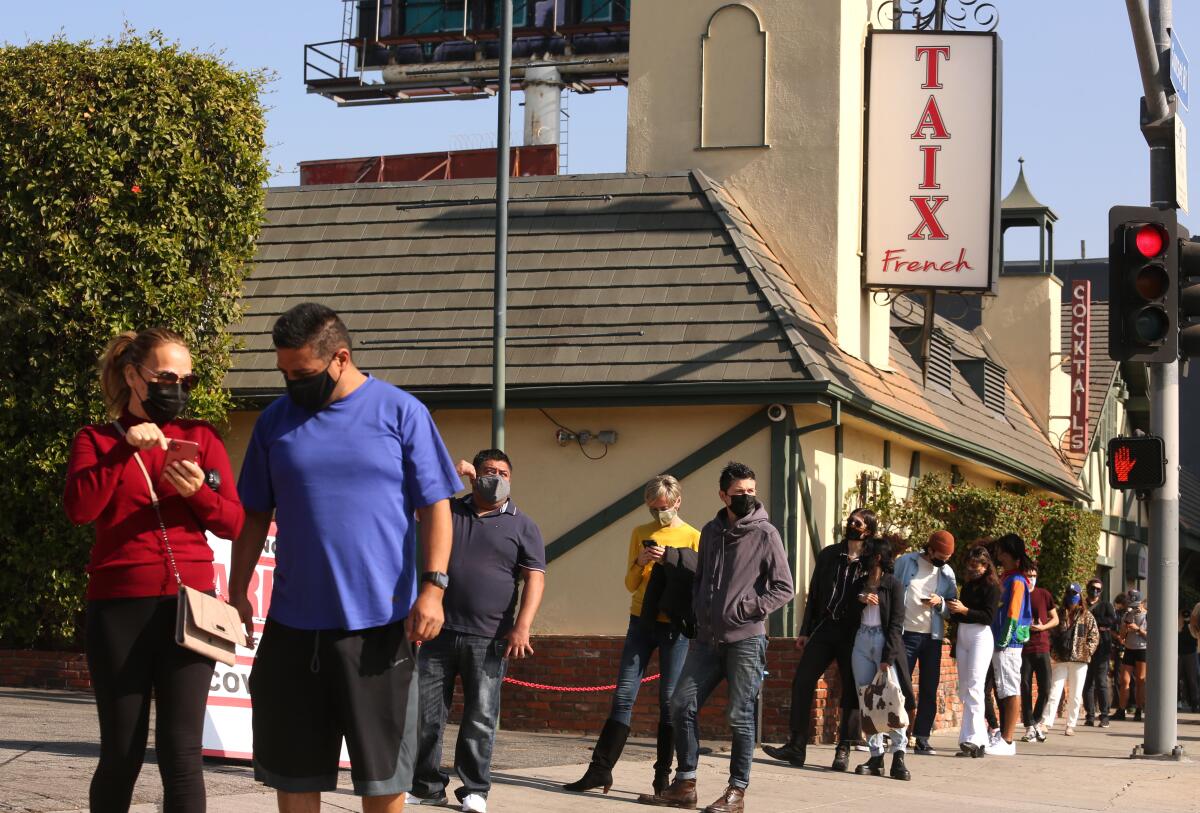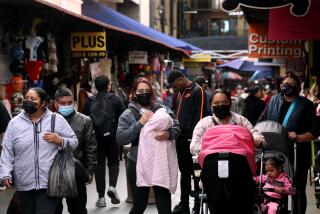New COVID-19 surge spreading beyond urban areas to all corners of California

The autumn COVID-19 surge has now spread not only through major urban areas like Los Angeles but even to the far northern rural reaches of California, a troubling sign as the state faces its greatest challenge yet from the pandemic.
A Times data analysis found that most California counties are now suffering their worst daily coronavirus case rates of the COVID-19 pandemic, surpassing even the summer surge that had forced officials to roll back the state’s first reopening in the late spring.
The data suggest California will face new problems in December if the unprecedented rise in cases continues. In earlier phases of the pandemic, different parts of California could help harder-hit areas — San Diego County and San Francisco, for example, took in patients from Imperial County. But that could be difficult in this wave, with the pandemic worsening in most places across California simultaneously.
“We can’t depend on our counties next to us, because they are under the same stress and strain,” said Dr. Marty Fenstersheib, the Santa Clara County coronavirus testing officer. “They can’t provide us with beds in their counties. So we are on our own. And our hospitals are hurting at this point.”
The Times’ analysis also demonstrates how the coronavirus has managed to break free from densely packed neighborhoods in urban areas and farming communities in agricultural valleys, where the virus infected essential workers — many of them Latino — who had no choice but to leave home to work.
Now, infections are spreading faster in other communities. In Marin County, health officer Dr. Matt Willis said the pandemic has moved from hitting predominantly Latino communities. Now, in just the last month, “the majority of cases are among our white residents,” Willis said.
Gov. Gavin Newsom has announced a stay-at-home order affecting most of California.
“We’re finding a greater proportion of those cases among people who are gathering indoors, and might have a more reasonable option to avoid those exposures, because they’re based on personal choices,” Willis told the Board of Supervisors. “It’s most discouraging that that’s what is driving it — but also encouraging because we think those are behaviors that people have more control over, because it’s not a matter of economic necessity.”
In just the last week, record average daily coronavirus case rates have hit L.A. and other hot spots such as San Bernardino and San Diego counties, The Times’ analysis found. Such areas have already received much attention in recent weeks as hospitals there have begun to fill and, in some cases, the daily death toll has risen. The crisis has only become exponentially worse in recent weeks.
Many other counties are also seeing record highs in their average daily case rates observed in the last week, according to The Times’ analysis, including Ventura, San Luis Obispo, Santa Clara, Sacramento, San Mateo, Solano and Santa Cruz. Counties across Northern California have also posted record highs in recent days, such as Napa County; Yolo County, home of UC Davis; Nevada, Placer and El Dorado counties, which sprawl from the state capital’s suburbs to Lake Tahoe; and sparsely populated Mariposa County, home to Yosemite Valley.
In all, more than 23 million Californians, living in 31 counties, are in what’s shaping up to be the worst wave of the pandemic, The Times’ analysis found.
Across California, the seven-day average of daily coronavirus cases has more than quadrupled since mid-October, from fewer than 3,000 a day to nearly 14,000 a day as of Wednesday. In just two weeks, average daily deaths have doubled: In the seven-day period that ended Wednesday, the state had an average of 74 COVID-19 deaths a day, up from 38.
As of Friday evening, California had a total of more than 1.18 million confirmed coronavirus cases in California and more than 19,000 related deaths, according to The Times’ coronavirus tracker.
Officials sounded alarm bells all over the state, from the Mexican border, where officials in Imperial County established an overflow medical tent with 50 beds to handle a surge in patients, to Shasta County in the far north, which reported hundreds of people in isolation and thousands in quarantine.
“Don’t make someone feel guilty for not wanting to gather in person,” said an announcement from the Shasta County Health and Human Services Agency. “Be clear: Say ‘no’ to anything that could increase risk for you or the people you care about.”
Besides Shasta County, other counties posting record average daily case rates since Nov. 18 include Calaveras, Del Norte, Glenn, Humboldt, Lassen, Mendocino, Plumas, Sierra, Siskiyou, Sutter, Tehama, Trinity, Tuolumne and Yuba counties, The Times’ analysis found.
The rate of coronavirus transmission in Los Angeles County is now at the highest since the first few weeks of the pandemic. Officials now estimate that every infected person, on average, transmits the virus to 1.27 other people.
“We have not seen [a transmission rate] this high in Los Angeles County since mid-March at the very beginning of the pandemic — before any of the prevention or safety measures were put into place,” said Dr. Christina Ghaly, the county’s director of health services.
That’s an especially distressing number given that L.A. County’s seven-day average of new daily coronavirus cases is about 4,300. The county is on pace to see the number of new daily coronavirus cases double in two weeks and quadruple in a month, Ghaly said.
Just last week, nearly 200 people a day were being admitted to hospitals in L.A. County; that number is now close to 300 hospital admissions daily, Ghaly said Wednesday. If disease transmission doesn’t dramatically change soon, hospitals in L.A. County could see anywhere from 375 to 1,000 new hospital admissions a day, she said.
Hospitals can ramp up their capacity if needed, but “that ability for hospitals to be able to surge and open up additional beds is not endless,” Ghaly warned; the number of available nurses and doctors who are trained in intensive care is limited.
Nursing homes are also seeing more cases. In remarks to the L.A. County Board of Supervisors on Tuesday, the director of public health, Barbara Ferrer, said the county is seeing an increase in coronavirus cases “among staff and residents at our skilled nursing facilities where many residents are medically fragile and at great risk for serious illness and death from COVID-19.”
In the last week, Ferrer said Monday, the county reported an additional 842 coronavirus cases among healthcare workers.
“This is the highest number of weekly cases we have seen in a very, very long time. And it’s a troubling increase, since it represents a huge number of new cases reported amongst healthcare workers just very recently,” Ferrer said. “The best way for each of us to show our gratitude is to take immediate actions that will stop spreading the virus.”
The number of outbreaks is also growing. From Halloween to mid-November, L.A. County reported a 67% jump in outbreaks at worksites and a tripling of outbreaks at food facilities, which include restaurants, food processing facilities, grocery stores, bottling plants and other food-related businesses.
Case rates in several regions of the state have far exceeded levels seen since the summer months, The Times’ analysis found.
Over the last seven days, Southern California counties reported an average of 40 daily coronavirus cases per 100,000 residents. That’s almost 50% higher than the summer peak, which was 28 daily coronavirus cases per 100,000 residents in July. The rate is even worse in the rural northern third of the state, where it has skyrocketed to an average of 48 daily cases per 100,000 residents, up from an average of 12 daily cases in August.
Cases in the Sacramento region and on the Central Coast have risen 57% and 22%, respectively, above the highest levels seen in mid-August. The nine-county San Francisco Bay Area is reporting 18 average daily cases per 100,000 residents, matching its summer peak.
A region that includes the San Joaquin Valley, the Eastern Sierra and Yosemite is the only one in California with case rates lower than its summer wave, which was extraordinarily bad. Those counties reported an average of 37 daily coronavirus cases per 100,000 residents, well below the previous peak of 55. The case rates in this section of inland Central California, however, are still increasing at a dramatic pace, on par with most other regions of the state.
Bay Area officials warned that the sharp jump in that region, too, is in danger of maxing out hospital capacity if the situation doesn’t change soon.
“Even in our own county hospitals, we’re seeing a strain on ICU beds,” said Santa Clara County Supervisor Cindy Chavez.
As some of the nation’s busiest shopping days approach, officials in Silicon Valley said they would roll out a ramped-up enforcement effort to ensure that crowds don’t form, stores adhere to capacity limits and people wear masks. Retailers can open at up to 25% of capacity in California counties in the most restrictive COVID-19 reopening tier, in which 95% of Californians live.
“We do not want crowds. A crowded situation promotes the spread of COVID,” said James Williams, county counsel for Santa Clara County.
Though officials had been issuing warnings before, a supersized staff of inspectors — which will include firefighters — is set to begin issuing citations that will result in fines.
In helping to enforce those pandemic restrictions, “we can save lives,” said Tony Bowden, chief of the Santa Clara County Fire Department.
Health officials have voiced grave concerns about reports of many people ignoring federal, state and local health recommendations to cancel travel plans for the Thanksgiving holiday. Authorities fear substantial travel will cause coronavirus transmission to further worsen, just as it did in China for the Lunar New Year, which fueled the initial spread that brought the contagious virus to the rest of the world.
“We’re hearing really distressing data that people are traveling. And that’s not good,” said Fenstersheib, the Santa Clara County coronavirus testing officer. With vaccines likely to be available in a matter of months, he urged the public to hold out on gatherings for just a few months longer.
Times staff writer Ryan Menezes contributed to this report.
More to Read
Start your day right
Sign up for Essential California for news, features and recommendations from the L.A. Times and beyond in your inbox six days a week.
You may occasionally receive promotional content from the Los Angeles Times.









